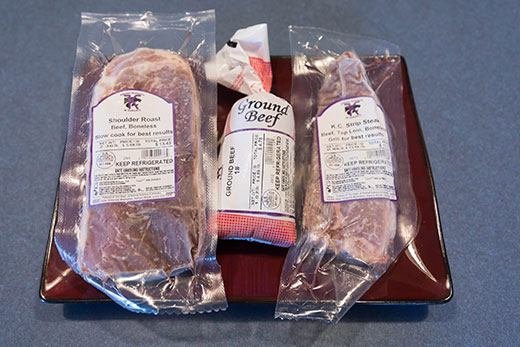
Products like those sold at the K-State meat lab are offered direct to local customers. | Download this photo
Considerations for marketing beef directly to consumers
Due to the COVID-19 limitations, consumers are looking to farmers and ranchers to fill the void
June 30, 2020
MANHATTAN, Kan. — Most will agree there is nothing that compares to the taste of fresh produce or meat that comes straight from the farm. And in light of perceived food shortages and a desire to know where their food comes from, an increasing number of consumers are seeking a farm-to-table purchasing experience.
Entrepreneurial producers working to fill the demand for homegrown beef should consider several factors before launching into this business, said Kansas State University experts during a recent Beef Cattle Institute Cattle Chat podcast.
“One of the first challenges is to find customers who are also going to be repeat buyers,” said K-State veterinarian Bob Larson.
Communicating with potential customers is key, but also with the processor, said agricultural economist Dustin Pendell. He said because of the increased demand, many processors are scheduling months out, which has an economic impact on the local community.
Pendell urged beef producers to think what product attributes lend themselves to a marketing niche. Some of the examples he shared were grass fed, antibiotic free, and known farm of origin as potentials for increased premiums.
“You need to educate yourself before entering one of these direct marketing ventures,” Pendell said.
K-State beef cattle extension specialist Bob Weaber said producers also need to decide how they want to sell their product —specifically by the carcass or by individual cuts.
“If I sell a half of beef to someone, they will pay the processing charges and they get all the yield,” he said. “But if I am selling meat by the cut that pricing model is substantially more complex. Finding a home for the less desirable cuts of meat can be a real challenge and, frankly, can make or break the deal.”
Weaber cautions direct marketers to consult with the processors to be sure that they are following all required government regulations on selling products.
K-State veterinarian Brad White stressed the importance of developing a business plan before deciding to market beef off the farm.
“If you are thinking about selling beef to consumers, make sure you communicate with your customers ahead of time, and have a value structure in place as part of your overall business plan,” White said.
Here is the quick summary of considerations for marketing direct to consumers:
- Plan for carcass utilization and pricing strategy.
- Identify relevant regulations.
- Meet customer product demands.
- Plan to communicate often with customers.
- Develop a business plan.

